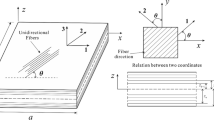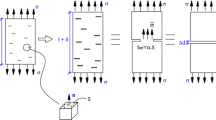Abstract
Structures that are difficult to maintain and access need to have an efficient and robust process for continuous monitoring. Such monitoring through damage detection and identification studies is present in several engineering applications as it allows that corrective measures be applied in order to guarantee the structural safety of a given structure, machine or equipment. In particular, laminated composite materials, often used in aeronautical structures, have a complex failure mechanism where delamination or cracks in these materials are often not visible on the surface. Thus, the use of optimization methods for the characterization of damages in these materials becomes relevant. In this study, both the metaheuristic sunflower optimization, the artificial neural networks and the response surface method were used to solve an inverse crack identification problem. The crack was modeled as a thin elliptical hole in a rectangular laminated plate numerically modeled using the finite element method. As a result of the methods used, different approaches to the problem were obtained that present reliable shape, size and position identification of a crack sized between 3 and 30 mm. The results showed substantial and promising results in the uses of both metaheuristic techniques and artificial neural networks. However, neural networks have a certain competitive advantage over optimization techniques as long as the data that feeds the model present a certain level of quantity and quality. Results obtained were able to identify all damage parameters (location, extension and orientation), with errors less than 1%.
















Similar content being viewed by others
Abbreviations
- K :
-
Stiffness matrix
- \(\omega _{j}\) :
-
jth natural frequency of interest
- M :
-
Mass matrix
- \(\phi _{{\left( {i,j} \right)}}\) :
-
Modal shift of the ith node in the jth mode of interest
- \(\hat{\phi }_{{\left( {i,j} \right)}}\) :
-
Modal shift of the ith node in the jth normalized mode of interest
- \(Q_{i}\) :
-
Amount of heat received by the ith plant
- P :
-
Source power
- \(r_{i}\) :
-
Distance between the sun and the ith plant
- \(\vec{s}_{i}\) :
-
Plant direction toward the sun
- X* :
-
Best individual parameter vector
- \(X_{i}\) :
-
Parameter vector of the ith plant
- \(d_{i}\) :
-
Step of the ith plant
- λ :
-
Constant value that defines an “inertial” displacement of the plants
- \(P_{i}\) :
-
Probability of reproduction of the ith plant
- \(X_{{\max }}\) :
-
Upper limit of the parameter vector
- \(X_{{\min }}\) :
-
Lower limit of the parameter vector
- \(N_{{{\text{pop}}}}\) :
-
Number of plants
- \(\vec{X}_{{\left( {i,j} \right)}}\) :
-
ITh plant in the jth generation
- \(v_{k}\) :
-
K Neuron linear combination factor
- \(w_{{kj}}\) :
-
Synapse weight between k and j neurons
- ϕ :
-
Activation function
- \(b_{k}\) :
-
Neuron k trend
- \(Y_{i}\) :
-
ITh response predicted by the artificial neural network
- \(\hat{Y}_{i}\) :
-
ITh response expected by the artificial neural network
- γ :
-
Regularization factor
- \(E_{x}\) :
-
Young's modulus in the x direction
- \(E_{y}\) :
-
Young's modulus in the y direction
- \(\nu _{{xy}}\) :
-
Poisson's ratio in the xy plane
- \(G_{{xy}}\) :
-
Shear modulus in the xy plane
- \(x_{{\text{o}}}\) :
-
Position of the center of the ellipse at x
- \(y_{{\text{o}}}\) :
-
Y Ellipse center position
- a :
-
Larger radius of the ellipse
- b :
-
Minor radius of the ellipse
- θ :
-
Inclination angle of the ellipse's largest radius in relation to the x axis
- \(f_{i}\) :
-
Ith natural frequency of interest (in Hz)
- t :
-
Parameter independent of the parametric equation of the ellipse
- \(x_{{\text{e}}}\) :
-
X rectangular enclosure size
- \(y_{{\text{e}}}\) :
-
Y rectangular enclosure size
- \(\phi _{{{\text{h}}(i,j)}}\) :
-
Modal shift of the ith plate node without damage in the jth mode
- \(\phi _{{{\text{d}}(i,j)}}\) :
-
Modal shift of the ith node of the damaged plate in the jth mode
- \(\Delta \hat{\phi }_{{\left( {i,j} \right)}}\) :
-
Difference between modal shift of the ith node of the real structure in the jth mode of interest and the undamaged structure
- \(\Delta \phi _{{\left( {i,j} \right)}}\) :
-
Difference between modal shift of the ith node in the jth mode
- ϕ h(i,j) :
-
Modal shift of the ith plate node without damage in the jth mode
- ϕ d(i, j):
-
Modal shift of the ith plate node with damage to the jth mode of interest
- J :
-
Objective function
References
Agathos, K., Chatzi, E., Bordas, S.P.A.: Multiple crack detection in 3D using a stable XFEM and global optimization. Comput. Mech. 62(4), 835–852 (2018)
Alexandrino, P.D.S.L., Gomes, G.F., Cunha, S.S., Jr.: A robust optimization for damage detection using multiobjective genetic algorithm, neural network and fuzzy decision making. Inverse Probl. Sci. Eng. 28(1), 21–46 (2020)
Budipriyanto, A., Haddara, M.R., Swamidas, A.S.J.: Identification of damage on ship’s cross stiffened plate panels using vibration response. Ocean Eng. 34(5–6), 709–716 (2007)
Chatzi, E.N., et al.: Experimental application and enhancement of the XFEM–GA algorithm for the detection of flaws in structures. Comput. Struct. 89(7–8), 556–570 (2011)
Doebling, S.W., et al.: A summary review of vibration-based damage identification methods. Shock Vib. Digest 30(2), 91–105 (1998)
Fathi, H., Vaez, S.H., Zhang, Q., Alavi, A.H.: A new approach for crack detection in plate structures using an integrated extended finite element and enhanced vibrating particles system optimization methods. In: Structures, vol. 29, pp. 638–651. Elsevier (2021, February)
Gomes, G.F., de Almeida, F.A.: Tuning metaheuristic algorithms using mixture design: application of sunflower optimization for structural damage identification. Adv. Eng. Softw. 149, 102877 (2020)
Gomes, G.F., & Giovani, R.S.: An efficient two-step damage identification method using sunflower optimization algorithm and mode shape curvature (MSDBI–SFO). Eng. Comput. 1–20 (2020). https://doi.org/10.1007/s00366-020-01128-2
Gomes, G.F., da Cunha, S.S., Ancelotti, A.C.: A sunflower optimization (SFO) algorithm applied to damage identification on laminated composite plates. Eng. Comput. 35(2), 619–626 (2019)
Gomes, G.F., da Cunha, S.S., Alexandrino, P.D.S.L., de Sousa, B.S., Ancelotti, A.C.: Sensor placement optimization applied to laminated composite plates under vibration. Struct. Multidiscip. Optim. 58(5), 2099–2118 (2018)
Gomes, G.F., Mendez, Y.A.D., Alexandrino, P.D.S.L., da Cunha, S.S., Ancelotti, A.C.: A review of vibration based inverse methods for damage detection and identification in mechanical structures using optimization algorithms and ANN. Arch. Comput. Methods Eng. 26(4), 883–897 (2019)
Hassiotis, S., Jeong, G.D.: Identification of stiffness reductions using natural frequencies. J. Eng. Mech. 121(10), 1106–1113 (1995)
Hossain, M.S., et al.: Artificial neural networks for vibration based inverse parametric identifications: a review. Appl. Soft. Comput. 52, 203–219 (2017)
Hu, H., Wang, J.: Damage detection of a woven fabric composite laminate using a modal strain energy method. Eng. Struct. 31(5), 1042–1055 (2009)
Karsh, P.K., Mukhopadhyay, T., Dey, S.: Spatial vulnerability analysis for the first ply failure strength of composite laminates including effect of delamination. Compos. Struct. 184, 554–567 (2018)
Kaveh, A., Mahdavi, V.R.: Colliding bodies optimization: a novel meta-heuristic method. Comput. Struct. 139, 18–27 (2014)
Khatir, S., Wahab, M.A., Benaissa, B., Köppen, M.: Crack identification using eXtended IsoGeometric analysis and particle swarm optimization. In: Fracture, Fatigue and Wear (pp. 210–222). Springer, Singapore (2018).
Liang, Y.C., Hwu, C.: On-line identification of holes/cracks in composite structures. Smart Mater. Struct. 10(4), 599 (2001)
Lu, Y., Ye, L., Su, Z., Zhou, L., Cheng, L.: Artificial neural network (ANN)-based crack identification in aluminum plates with Lamb wave signals. J. Intell. Mater. Syst. Struct. 20(1), 39–49 (2009)
Mukhopadhyay, T., et al.: Structural damage identification using response surface-based multi-objective optimization: a comparative study. Arab. J. Sci. Eng. 40(4), 1027–1044 (2015)
Oliver, G.A., Ancelotti, A.C., Gomes, G.F.: Neural network-based damage identification in composite laminated plates using frequency shifts. Neural Comput. Appl. 33(8), 3183–3194 (2021)
Owolabi, G.M., Swamidas, A.S.J., Seshadri, R.: Crack detection in beams using changes in frequencies and amplitudes of frequency response functions. J. Sound Vib. 265(1), 1–22 (2003)
Pereira, J.L.J., Francisco, M.B., da Cunha Jr, S.S., Gomes, G.F.: A powerful Lichtenberg Optimization Algorithm: a damage identification case study. Eng. Appl. Artif. Intell. 97, 104055 (2021)
Pereira, J.L.J., Chuman, M., Cunha Jr, S.S. and Gomes, G.F. (2021), "Lichtenberg optimization algorithm applied to crack tip identification in thin plate-like structures", Engineering Computations, Vol. 38 No. 1, pp. 151–166. https://doi.org/10.1108/EC-12-2019-0564
Rashedi, E., Nezamabadi-Pour, H., Saryazdi, S.: GSA: a gravitational search algorithm. Inf. Sci 179(13), 2232–2248 (2009)
Saeed, R.A., Galybin, A.N., Popov, V.: Crack identification in curvilinear beams by using ANN and ANFIS based on natural frequencies and frequency response functions. Neural Comput. Appl. 21(7), 1629–1645 (2012)
Sankar, P.A., Machavaram, R., Shankar, K.: System identification of a composite plate using hybrid response surface methodology and particle swarm optimization in time domain. Measurement 55, 499–511 (2014)
Stinchcomb, W., Reifsnider, K.: Fatigue damage mechanisms in composite materials: A review. In Fatigue Mechanisms, ed. J. Fong (West Conshohocken, PA: ASTM International, 1979), 762–787. https://doi.org/10.1520/STP35914S
Sun, H., Waisman, H., Betti, R.: Nondestructive identification of multiple flaws using XFEM and a topologically adapting artificial bee colony algorithm. Int. J. Numer. Methods Eng. 95(10), 871–900 (2013)
Varna, J., et al.: Damage in composite laminates with off-axis plies. Compos. Sci. Technol. 59(14), 2139–2147 (1999)
Waisman, H., Berger-Vergiat, L.: An adaptive domain decomposition preconditioner for crack propagation problems modeled by XFEM. Int. J. Multiscale Comput Eng 11(6) (2013)
Wei, Z., Liu, J., Lu, Z.: Structural damage detection using improved particle swarm optimization. Inverse Probl. Sci. Eng. 26(6), 792–810 (2018)
Yang, Xin-She.: Flower pollination algorithm for global optimization. In International conference on unconventional computing and natural computation. Springer, Berlin, Heidelberg, (2012)
Acknowledgements
The authors would like to acknowledge the financial support from the Brazilian agency CNPq and FAPEMIG (Fundação de Amparo à Pesquisa do Estado de Minas Gerais – Grant APQ-00385-18).
Author information
Authors and Affiliations
Corresponding author
Ethics declarations
Conflict of interest
The authors declare that they have no conflict of interest.
Replication of results
This manuscript is self-contained, in that it contains all necessary theory to reproduce the results, including the preliminaries, i.e., the inverse crack identification in laminate composite plates. The formulation of the inverse problem is described in detail, and all parameters for the numerical examples are provided.
Additional information
Publisher's Note
Springer Nature remains neutral with regard to jurisdictional claims in published maps and institutional affiliations.
Rights and permissions
About this article
Cite this article
de Assis, F.M., Gomes, G.F. Crack identification in laminated composites based on modal responses using metaheuristics, artificial neural networks and response surface method: a comparative study. Arch Appl Mech 91, 4389–4408 (2021). https://doi.org/10.1007/s00419-021-02015-y
Received:
Accepted:
Published:
Issue Date:
DOI: https://doi.org/10.1007/s00419-021-02015-y




